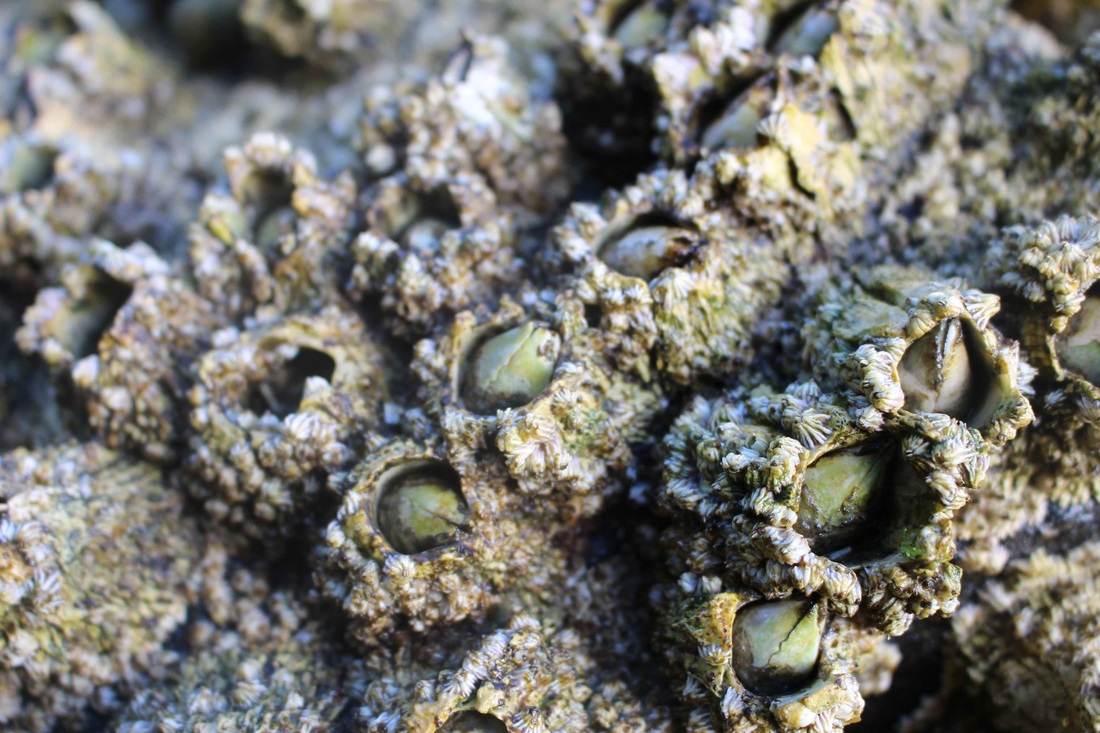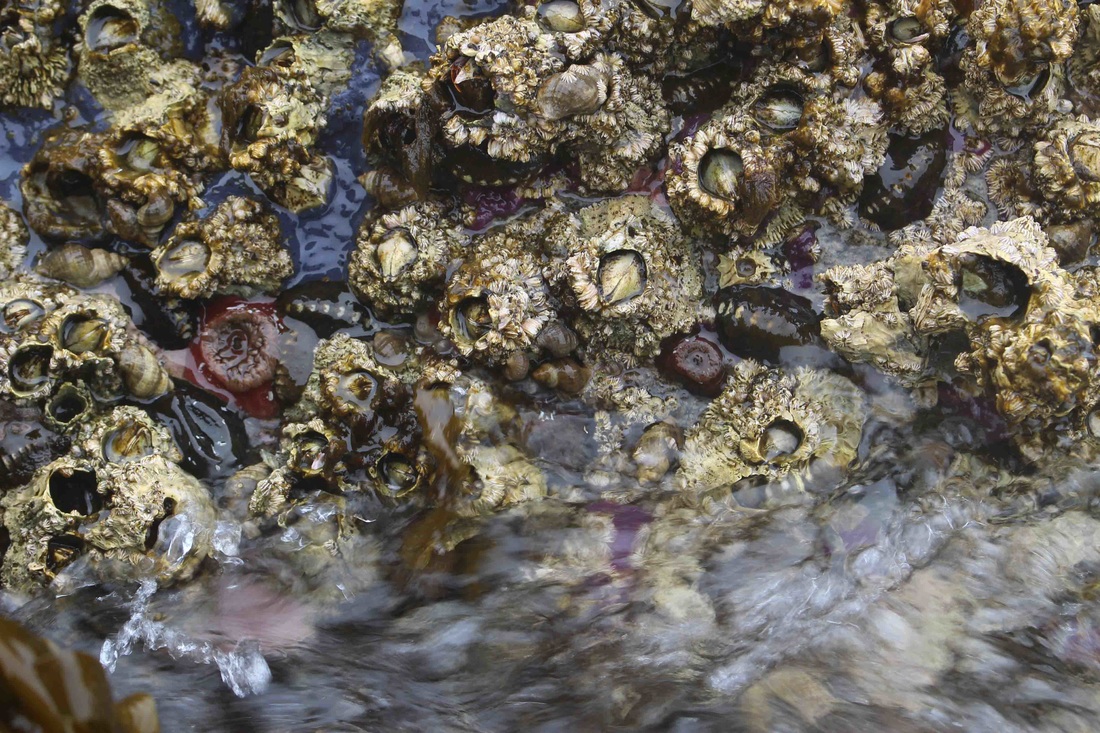Giant acorn barnacle • Balanus nubilus
|
Top: large intertidal examples of giant acorn barnacles, covered with smaller thatched acorn barnacles (Semibalanus cariosus) — identifiable by their heavily ridged sides — and (likely) common acorn barnacles (Balanus glandula). Nestled between the barnacles in the right-hand image are black katy chitons, patches of purple encrusting sponge, anemones, and sea snails. Photos by Sara Wickham. Bottom left: giant acorn barnacles feeding, among plumose anemones. Photo by Jenn Burt.
|
Identification
At a maximum diameter of 15 cm (equivalent to half a foot), the giant acorn barnacle is possibly the largest barnacle species in the world, and is definitely the largest in North America. If an individual is not large enough for its identity to be obvious, other features can be used to identify this species: it has a broad opening (aperture) in relation to its base, its aperture edge is jagged and rough, its exterior is often heavily worn and eroded, and its terga (interior movable plates that form the operculum) are beak-shaped and extend out of the aperture. Flashes of bright yellow, orange, or purple tissue are visible inside when these operculum plates open during feeding. Younger individuals start off with ribbed plate exteriors, but these ridges usually wear away with age.
Habitat & Range
This barnacle tends to aggregate into clusters and can form large reef-like formations, but may also be found singly. It inhabits the intertidal and subtidal to 90 m deep, where it grows on rocks and pilings and prefers areas with strong currents or waves. Individuals often also grow on one another. Its range extends from southern Alaska to Baja California, Mexico.
Similar Species
Large thatched barnacles (Semibalanus cariosus) that have undergone erosion and lost their heavy ribbing and finger-like base projections or thatching may be confused with this species. Thatched barnacles also have beak-like terga, and can reach 6 cm in diameter.
Intriguing Info
Empty casings left behind by dead giant acorn barnacles often become hiding places for other animals, such as small and juvenile fish, the pygmy rock crab (Glebocarcinus oregonensis), and the Pacific red octopus (Octopus rubescens). Some fish species also depost eggs in these empty casings. The giant acorn barnacle is preyed upon by the ochre star (Pisaster ochraceus).
At a maximum diameter of 15 cm (equivalent to half a foot), the giant acorn barnacle is possibly the largest barnacle species in the world, and is definitely the largest in North America. If an individual is not large enough for its identity to be obvious, other features can be used to identify this species: it has a broad opening (aperture) in relation to its base, its aperture edge is jagged and rough, its exterior is often heavily worn and eroded, and its terga (interior movable plates that form the operculum) are beak-shaped and extend out of the aperture. Flashes of bright yellow, orange, or purple tissue are visible inside when these operculum plates open during feeding. Younger individuals start off with ribbed plate exteriors, but these ridges usually wear away with age.
Habitat & Range
This barnacle tends to aggregate into clusters and can form large reef-like formations, but may also be found singly. It inhabits the intertidal and subtidal to 90 m deep, where it grows on rocks and pilings and prefers areas with strong currents or waves. Individuals often also grow on one another. Its range extends from southern Alaska to Baja California, Mexico.
Similar Species
Large thatched barnacles (Semibalanus cariosus) that have undergone erosion and lost their heavy ribbing and finger-like base projections or thatching may be confused with this species. Thatched barnacles also have beak-like terga, and can reach 6 cm in diameter.
Intriguing Info
Empty casings left behind by dead giant acorn barnacles often become hiding places for other animals, such as small and juvenile fish, the pygmy rock crab (Glebocarcinus oregonensis), and the Pacific red octopus (Octopus rubescens). Some fish species also depost eggs in these empty casings. The giant acorn barnacle is preyed upon by the ochre star (Pisaster ochraceus).
References
Cowles, D. (2006). Balanus nubilus Darwin, 1854. Invertebrates of the Salish Sea. Rosario Beach Marine Laboratory. Accessed 27/01/2016.
Lamb, A., and Hanby, B. (2005). Marine Life of the Pacific Northwest [electronic version]. Madeira Park, BC: Harbour Publishing.
Watanabe, J. M. (2015). Balanus nubilus Darwin, 1854. SeaNet: Common Marine Organisms of Monterey Bay, California. Stanford University, Stanford CA. Accessed 27/01/2016.
Authors and editors of page
Kelly Fretwell (2016).
Cowles, D. (2006). Balanus nubilus Darwin, 1854. Invertebrates of the Salish Sea. Rosario Beach Marine Laboratory. Accessed 27/01/2016.
Lamb, A., and Hanby, B. (2005). Marine Life of the Pacific Northwest [electronic version]. Madeira Park, BC: Harbour Publishing.
Watanabe, J. M. (2015). Balanus nubilus Darwin, 1854. SeaNet: Common Marine Organisms of Monterey Bay, California. Stanford University, Stanford CA. Accessed 27/01/2016.
Authors and editors of page
Kelly Fretwell (2016).






